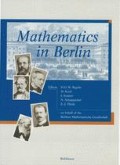Abstract
The early development and untimely death of a genius is a well-known theme in general (“Whom the gods love …”), and in musical biography in particular, with Mozart and Schubert as outstanding examples. But three geniuses among the nineteenth century mathematicians, whose lives were cut off all too soon, make Mozart’s death at close to 37 years, and even Schubert’s at hardly less than 32 years, almost seem to have come at a reasonably mature age. The mathematicians are Evariste Galois — who lost his life at 20 in an absurd duel, Niels Henrik Abel — who succumbed to tuberculosis at age 26, and finally Gotthold Eisenstein, whose frail body held out exactly 1000 days longer than Abel’s, before giving in to the same disease.
Access this chapter
Tax calculation will be finalised at checkout
Purchases are for personal use only
Preview
Unable to display preview. Download preview PDF.
References
Adler, A., Eisenstein and the Jacobian varieties of Fermat curves, Rocky Mountain Journal of Mathematics 27 (1997), 1–60.
Biermann, K.-R., Eine Selbstbiographie von G. Eisenstein, Mitt. Math. Ges. DDR, Heft 3-4 (1976), 150–154.
Eisenstein, G., Mathematische Werke, 2 vols., Chelsea, 1975.
Klein, F., Vorlesungen über die Entwicklung der Mathematik im 19. Jahrhundert, Teil I, Springer-Verlag, Berlin, 1926.
Roerdansz, A., Ein Freiheits-Martyrium, Gefangene Berliner auf dem Transport nach Spandau am Morgen des 19. März 1848, Protocollarische Aussagen und eigene Berichte der 91 Betheiligten, als Beitrag zur Geschichte des Berliner Märzkampfes gesammelt und herausgegeben von Adalbert Roerdansz, Berlin, 1848.
Weil, A., Elliptic functions according to Eisenstein and Kronecker, Ergeb. Math. 88, Springer-Verlag, Berlin, 1976.
Weil, A., On Eisenstein’s Copy of the Disquisitiones, in: Coates, J., Greenberg, R., Mazur, B., Satake, I. (eds.), Algebraic Number Theory — in honor of Kenkichi Iwasawa, Advanced Studies in Pure Mathematics 17, Academic Press, Princeton, 1989, 463–469.
Editor information
Editors and Affiliations
Rights and permissions
Copyright information
© 1998 Springer Basel AG
About this chapter
Cite this chapter
Schappacher, N. (1998). Gotthold Eisenstein. In: Begehr, H., Koch, H., Kramer, J., Schappacher, N., Thiele, EJ. (eds) Mathematics in Berlin. Birkhäuser, Basel. https://doi.org/10.1007/978-3-0348-8787-8_7
Download citation
DOI: https://doi.org/10.1007/978-3-0348-8787-8_7
Publisher Name: Birkhäuser, Basel
Print ISBN: 978-3-7643-5943-0
Online ISBN: 978-3-0348-8787-8
eBook Packages: Springer Book Archive

